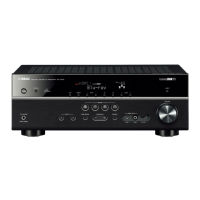
Do you have a question about the Yamaha RX-V575 and is the answer not in the manual?
| Receiver type | Surround |
|---|---|
| Audio output channels | 7.2 channels |
| Dynamic power per channel (4 Ohm) | 140 W |
| Power output per channel (1KHz@6 Ohm) | 135 W |
| Power output per channel (1KHz@8 Ohm) | 115 W |
| Power output per channel (20-20KHz@8 Ohm) | - W |
| HDMI in | 5 |
| Audio (L/R) in | 4 |
| Ethernet LAN (RJ-45) ports | 1 |
| Component video (YPbPr/YCbCr) in | 2 |
| Speakers connectivity type | - |
| Ethernet LAN | Yes |
| Supported radio bands | AM, FM |
| Optical drive included | No |
| Display | LED |
| Product color | Black |
| Audio decoders | Dolby Digital Plus, Dolby Pro Logic IIx, Dolby TrueHD, DTS-HD Master Audio |
| Volume control | Rotary |
| Apple docking compatibility | Not supported |
| Power consumption (standby) | 0.1 W |
| Depth | 315 mm |
|---|---|
| Width | 435 mm |
| Height | 161 mm |
| Weight | 8200 g |
Overview of the AV receiver's capabilities and supported content.
Identification and description of controls and indicators on the front of the unit.
Explanation of the various indicators displayed on the unit's front panel.
Diagram and explanation of the rear panel's input and output jacks.
Identification of buttons and functions on the remote control for operating the unit.
Step-by-step guide to connect and configure the AV receiver for initial use.
Detailed explanation of various audio and video connection jacks and required cables.
Instructions on how to position speakers and subwoofers in your room for optimal sound.
Guidance on connecting speaker cables to the unit for different channel configurations.
Methods for connecting a TV to the AV receiver, including HDMI Control and ARC.
How to connect various video and audio playback devices using HDMI, MHL, component, or composite connections.
Instructions for connecting the supplied FM and AM antennas for radio reception.
Guide to connect the unit to a network for Internet radio and media streaming.
How to connect recording devices to the AV OUT jacks for analog audio/video signal output.
Instructions for safely connecting the unit to a power source, including voltage selection.
How to choose the desired language for the unit's on-screen menus.
Guide to using the YPAO system to automatically calibrate speaker settings for optimal room acoustics.